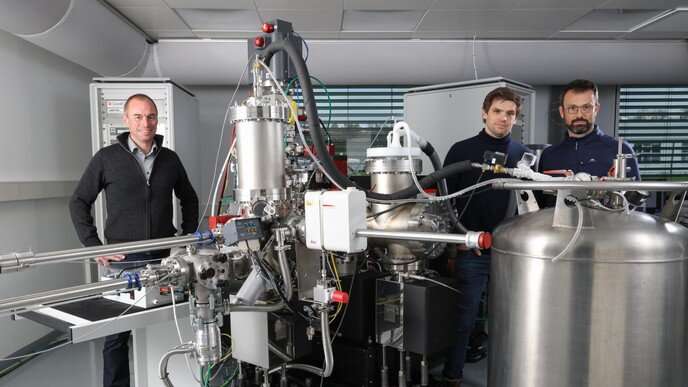This article has been reviewed according to Science X's editorial process and policies. Editors have highlighted the following attributes while ensuring the content's credibility:
fact-checked
peer-reviewed publication
trusted source
proofread
Scientists unlock new horizons for cryogenic microscopy

EPFL scientists have developed a new research instrument for observing biological tissue samples prepared using a method discovered about forty years ago by Nobel Prize winner Jacques Dubochet, emeritus professor at the University of Lausanne. Their instrument—the only one of its kind in the world—opens up promising new avenues of research.
It took Prof. Anders Meibom and his research group almost 10 years and several prototypes before they finally made it. They have now succeeded in enhancing an analysis method known as nanoscale secondary ion mass spectrometry (NanoSIMS) by building a CryoNanoSIMS machine—an instrument that can analyze the chemical and isotopic composition of vitrified tissue samples.
The sample preparation process they used was developed in the 1980s by the well-known Vaud biophysicist Jacques Dubochet—who won the 2017 Nobel Prize in Chemistry for that breakthrough. That process, which forms the basis of modern cryogenic electron microscopy, preserves all constituents of a biological sample in their most pristine post-mortem state. The research group's CryoNanoSIMS machine and potential benefits are described in an article published in BMC Biology.
"We're now able to generate images of precisely where in a cell or tissue sample a specific nutrient is stored or used, or where a given drug enters—or does not enter. There's no other way to obtain this information," says Meibom, who heads the Laboratory for Biological Geochemistry at EPFL's School of Architecture, Civil, and Environmental Engineering and who is also a professor at the University of Lausanne (UNIL).
New research horizons
With the CryoNanoSIMS machine, scientists can take cryogenically prepared biological tissue samples—in which no molecules have been lost or even displaced—and directly observe the exact sub-cellular distribution of compounds essential for the treatment of bacterial infection and cancer, for example. Scientists can also use the machine to visualize the distribution of trace elements in plant tissue, which is critically important for improving plant growth and crop production and tracing environmental contaminants in soil and biofilms. And all this can be done at a sub-cellular spatial resolution. "Our CryoNanoSIMS instrument creates entirely new research opportunities," says Meibom.
"In my lab, we're in full swing developing an intense research program around this unique capability." Meibom's CryoNanoSIMS laboratory is housed at UNIL, where it is part of the Center for Advanced Surface Analysis, a consortium of laboratories from both UNIL and EPFL that use state-of-the-art equipment to conduct elemental and isotopic surface analyses for a wide range of research topics spanning from geology to biology. Commenting on the new instrument, Dubochet heralds it as "an important expansion of the field of biological chemistry."
Swiss precision
NanoSIMS technology already revolutionized the field of imaging when it was introduced around 20 years ago. It entails directing a beam of ions onto a sample and produces images with 100 nm resolution. But the associated sample preparation methods all result in some degree of tissue morphology distortion and loss of soluble compounds. To overcome these obstacles, Meibom and his team developed a cryogenic process for preparing samples and added new physical components, including a liquid nitrogen tank, to a NanoSIMS machine so that it can accommodate cryogenic samples.
"It was extremely difficult to turn an instrument that operates at room temperature into one that can analyze frozen tissue samples while keeping the sample cold and stable for hours and hours. But we succeeded, and can now obtain entirely new information," says Meibom. "None of this would have been possible without the mechanical engineering skills of EPFL's workshops and of the Swiss firms we worked with to achieve the required degree of precision for specific parts."
From hydra to corals
The study's authors tested their CryoNanoSIMS method on samples of Green Hydra, a small animal that lives in freshwater ponds and lakes, including in Switzerland. With the CryoNanoSIMS they could directly observe how this animal takes up and assimilates ammonium, a key nutrient for many aquatic organisms.
The next step will be to apply the method to corals—another area of expertise at Meibom's lab—so that scientists can study the symbiosis mechanisms between algae and coral and determine the factors that lead to coral bleaching and death.
More information: Anders Meibom et al, Correlated cryo-SEM and CryoNanoSIMS imaging of biological tissue, BMC Biology (2023). DOI: 10.1186/s12915-023-01623-0
Journal information: BMC Biology
Provided by Ecole Polytechnique Federale de Lausanne





















